Loading...
http://info.51.ca/news/canada/2017-12/604368.html
来源:加国无忧编译
下周天(12月17日)旺市将迎来25年来最重大的一件事之一——要通地铁了!约克区终于有地铁可以通往多伦多了!

这条Toronto-York Spadina Subway Extension地铁延长线从开始筹划到施工用了超过十年时间,起初预计建造这条延长线的花费为26亿加元,最终共投入32亿。
在这条延长线正式开通前,你需要知道这十件事:
1. 每次搭乘TTC地铁的成人票价是3.25元,学生(13岁到19岁)和长者(65岁以上)每次乘车费是2.1元,12岁及以下儿童免费乘坐。购买特价票的人最好能随身携带身份证件,可以证明自己的年龄。乘车可用现金、代币(token)、Presto卡付费,但可能从明年起将不能再用现金和代币,因此TTC鼓励乘客都改用Presto卡。
2. 使用Presto卡的乘客每次上车前只要刷一下卡即可。你想预存多少钱到卡里都可以,刷卡之后,每次乘车的费用将被自动扣除。
3. 每周一到周六,地铁的运营时间是早上6点到第二天凌晨1点半,周天的运营时间是从早上8点开始,一直到凌晨1点半。圣诞节和元旦当天的地铁服务从早上9点开始。
4. 从多伦多延伸到旺市的TTC地铁线将在旺市区域内开通三个站点:Jane与Hwy 7附近的Vaughan Metropolitan Centre地铁站、Hwy 407与Jane 附近的Hwy 407地铁站以及Steeles Avenue West与Northwest Gate附近的Pioneer Village地铁站。

Vaughan Metropolitan Centre地铁站
5. 这三个站点附近都设有停车场,Vaughan Metropolitan Centre地铁站有900个停车位,Hwy 407地铁站有583个车位,Pioneer Village地铁站有1881个车位。

Hwy 407地铁站
6. 在周一到周五的工作日期间,早上8点前和下午4点半以后在Vaughan Metropolitan Centre地铁站的停车费是5元,上午8点到下午4点半之间的停车费是12元。该地铁站周末停车费全天5元。Hwy 407站和Pioneer Village站的停车费还没有确定,但预计会与TTC其他站的收费标准差不多。

Pioneer Village地铁站示意图
7. 这三个地铁站都可连接其他公交系统,Viva公车可沿着Hwy 7带你直达Vaughan Metropolitan Centre地铁站。
8. 除了这三个在旺市的地铁站外,延长线上还有另外三个地铁站点(在多伦多市区域):York University 站、Finch West 站和 Downsview Park 站。如果从旺市的Vaughan Metropolitan Centre地铁站搭乘地铁到多伦多市中心的Union Station地铁站,共需要43分钟。

TTC地铁线路图
9. 不是所有的地铁站都设有洗手间,但Vaughan Metropolitan Centre站内有。而且这条延长线上的六个新站点都可使用洗手间。
10. 想了解更多有关TTC或延长线的信息,可以登录TTC网站或关注其官方脸书、Twitter、Instagram等社交媒体账号。
来源:港股那点事(hkstocks)
周末看电视突然看到深圳房价的大新闻,在严厉的调控下,深圳新房均价连跌了14个月,11月的均价同比下降了10元/平米,一套100平的房子能省1000块,吓死宝宝了!
实际上,在限价等原因下,一手新房房价已经失真,从链家的数据看,二手房价自去年国庆调控基本保持平稳,而且还微微有些上升,调控手段奇招百出最后也只是压制了短期的涨幅,压得了一时压不了一世。
深圳现在的房价,借用任志强的话说:“他们老说房价高,我觉得还早着呢。”
▌一、谁被低估了?
价格嘛,贵不贵就是比出来,就跟股票估值一样,找一个相似的标杆比一比就知道了,深圳对面的香港就是一个最好的参照物了。
中原地产的房价指数,除了在香港在1998年金融风暴时下跌,颓势持续到2003年非典,之后就一直在拉升,现在香港的均价差不多是12万元人民币每平米,深圳是5.4万左右,香港是深圳的2.2倍。
一河两地,两个价格看似也合理,但是,随着广深港高铁的开通,这个合理性基石已经是风雨飘摇了。
广深港高铁香港段计划于2018年三季度正式通车,11月18日香港与广东签署了《内地与香港特别行政区关于在广深港高铁西九龙站设立口岸实施“一地两检”的合作安排》,也就是说西九龙站将参照深圳湾口岸现行模式,实施“一地两检”安排,即离港及抵港旅客可在同一楼层内完成出入境、清关和检验检疫手续。
全线建成后,从西九龙至福田仅14分钟。14分钟的车程,价格却天壤之别,这合理吗?
链家二手房的成交数据显示福田区均价仅6.4万,周末去福田看房,位置、户型都很不错的房子,价格是10万出头。高铁西九龙站在香港的九龙地铁站和柯士甸地铁站之间,中原香港的二手楼数据看,每平米要25万-35万人民币。
打个比方,有投资港股就深有体会,2014年沪深港三地证券市场开启了互联互通,打通了资金流动的桥梁,港股低估值生态发生质变,造就了今年香港牛市。广深港高铁也打通了广深港人口流动的任督二脉,未来两地的房价差也很可能会发生质变。
那么是深圳低估了,还是香港高估了?我想是深圳低估了。
导致香港楼市不断热炒的核心因素是供给短缺,在八万五计划失败后,土地供应压缩至冰点,物以稀为贵,在如此严峻的供给下,价格如何不高呢?香港房价反映了正常的供需水平,所以问题是不大的。
而深圳比之香港供应更加紧张,因为深圳是真没地。
就辖区面积而言,深圳全市国土面积为1993平方千米,是1.8个香港,却是一线城市里最小的,北京面积相当于8个深圳,上海相当于3个深圳,邻居广州也相当于4个深圳,直辖市重庆相当于40个深圳,差距更大。
1979年春天邓公在中国南海边陲之地画下一个小圈时,应该也不会想到三十载时间深圳能发展如此快。卫星图上看到深圳的开发建设土地占比已经很高了,深圳建成区面积为900平方千米,建设用地面积占全部国土面积的45%,高于香港(24%)和其他一线城市(广州18%,北京22%,上海37%)。
根据深圳市的规划,到2020 年,深圳建设用地上限是976 平方公里,截至2015 年已使用940平方公里。这意味着,2016 年起,深圳只有30 平方公里的新增建设用地指标,平均每年仅6平方公里新增建设用地配额,还得分大部分给商服、商业等,分到住宅头上少的可怜。
直接看近几年深圳土地供应就可以一目了然,以深圳商品房住宅市场为例,深圳新增住宅土地近几年保持在很低的水平,纵向看也是所有一线城市中最低。
有限的供给最后呈现的结果就是,在过去房地产快速发展的15年里,全部的商品住宅销售分到每个人头上的人均面积要远低于其他一线城市。即使考虑到保障房等,采用竣工总面积计算的人均面积也是很低的。
土地是用一块就少一块,土地的不可再生及有限性决定了未来深圳土地供给也难有大作为。可选项很少,不外乎在存量中做文章,比如城市更新,但是现如今城市更新的周期在不断拉长,成本也越来越高,远水难解近渴。又或者学习香港填海,填海用地成本更高,又有多少能用于住宅,注定也是杯水车薪。
所以,是深圳被低估了。
▌二、国运担当
而且,更重要,也是铁一般的事实:深圳在蒸蒸日上,香港却日渐暗淡。
回归那年,上海的GDP只有香港的23%,深圳GDP相对于香港几乎可以忽略不计,但12年后上海GDP就一举超越香港,并将这个差距越拉越大,而深圳也迎头赶上,现在GDP已与香港相差无几,并且以更高速度在增长,根据最新修订的统计口径,深圳GDP已破2万亿。估计用不了两年,GDP超越香港,几乎毫无悬念:
香港的崛起之源也是深圳超越之因。
在上世纪60年代,美日等国人口增长下降,劳动力成本上升,开始发展钢铁、化工等资本密集型产业,转移劳动密集型产业。
到了70年代,爆发石油危机,能源、矿产资源价格上涨,美日等开始发展技术密集型产业,转移资本密集型产业。
在上世纪的国际产业转移浪潮中,香港政府与香港人抓住了历史的契机,成功地一跃成为一个富裕的发达经济体。
在新世纪,科技革命、信息技术逐渐成为经济发展的新动力。但这次,香港却掉链子了,而深圳则后来者居上,抓住了历史性的互联网科技的发展机遇。
凭借不断创新,打造了众多世界知名的高科技公司和创业公司,上市公司的市值已经超过上海。腾讯、华为已经是深圳的老名片了,现在还有源源不断的如华大基因、大疆无人机这种新的城市名片陆续冒出来。
一个城市的命运除了靠自身的奋斗,还要看历史的进程,而其命运是与产业紧紧绑在一起的。幸运如深圳,选择的是高新产业,代表了未来,也是未来国运兴衰关键。高新产业正处在风口,也吸引了人才不断的流入,高技术人才催化技术进步,政府能收取更多的税收,给予高新产业更多的支持,形成良性循环。不幸如东北,在重工业蓬勃发展时没有及时转型,错过新时代的红利,人才不断流出,即使有资源有心也无人可用,形成的是恶性循环。最后,就是差距越来越大。
城市也有核心资产和非核心资产之分,无疑,深圳代表了中国国运,是城市中绝对的核心资产。
▌三、源源不断人口流入
占据了产业优势,就占领了未来。
水往低处流,人往高处走,必然就会吸引人源源不断往核心城市聚集,尤其是代表了未来的深圳,人口多了对房子的需求自然就上升(不论是自住还是投资等需求)。
一线城市中北京、上海因为本身城市规划原因,开始主动限制人口流入,落户门槛一年比一年高,比移民美利坚还难,甚至主动把人往外赶。理由是,居住地存消防隐患等,事实也是如此,但是,为什么这些人宁愿住着不安全、恶劣的房子也要留在北京?因为回到三四线,甚至五险之外的老家,就没有收入了。
所以,城市不断扩大,再外溢形成城市群是必然的趋势。
而广州和深圳的常住人口还保持不断增长,像深圳每年增加净流入50多万人,不过深圳2016年新房成交只有4万套,按套均3人计算也只能解决12万人需求。
其中,区域人口增长分为自然增长(出生率减死亡率)和流动增长(迁入减迁出),用流动增长更能说明人口流动。从下图可以看到,三大经济圈中北京和上海都较为弱势,数珠三角人口迁入最为活跃,而深圳是净迁入最多的城市。
深圳还是一线城市中人才引进力度最大的一线城市,本科毕业生就能申请落户,而且除了深圳市有一次性的住房补贴,各区还有额外的住房补贴,在抢人大战中无疑占得先机,深圳人口净流入的基调大概率是会保持的。
除了看人口流入规模,人口结构是更重要的一个指标。
深圳2015年人口普查数据显示,65岁及以上人口为38.37万人,占3.37%,而在2010年全国人口普查数据显示65岁人口占比就达到8.87%。
小学生数量变化也可以管中窥豹。我国实行9年义务教育,小学入学率是100%,小学生数量是数人头得出的,数据更靠谱,而且城市化加快,民众生育意愿降低,如果一个城市的小学生数量增长加快,更能证明年轻人口流入并选择结婚生子,落地生根。深圳2010年以来小学生数量保持平稳向上,说明婚育年龄的人口比重在增加。
而与全国的人口自然增长率一对比深圳人口的质量更一目了然,2003年以来人口自然增长率基本保持上扬,而且与全国的平均水平差距越拉越大,也说明了人口年龄结构比较年轻,内生性更好。
看到这里就知道深圳的供需是极度失衡的,采用限价限贷等方法只是“堵”,而不是“疏”,而深圳无地可用,要疏也很难,要摁住深圳的房价比大禹治水还难。现在的调控手段把资金流一刀切断,就像在一条大河里筑起大坝,但是改变不了水的流向,蓄起来的水一放,该往哪里流还是得往哪里流,资金亦如是。
曼哈顿贵,是因为曼哈顿不止是纽约人的曼哈顿,也不止是美国人的曼哈顿,是世界的曼哈顿,而北上广深,是全国13.6亿人的北上广深,全国高净值人都是深圳房子潜在的需求者。
所以,不管买不买得起,说句公道话:深圳的房价真不贵。
▌尾声:
自1998年房改以来,房价基本3年一个周期,上一轮调控是2013年到2015年,而这一轮暴涨是从深圳开始的,2015年上半年就启动了,2016年率先见顶横盘,掐指一算2018年下半年差不多就是调控结束之时。
拥有腾讯、华为、华大基因的深圳与中国国运紧紧相连,赌深圳就是赌国运,有信心者,应该想方设法押注深圳,不论是买房、还是就业,或者其他任何方式,不然结局就是生无可恋,死无可葬。
如是买房,记住房地产投资的核心定律:中心,即“中心城市的城市中心”。
根据深圳的十三五规划,未来城市呈三轴两带发展,其中两大绝对主力中心是“福田-罗湖中心”、“前海中心”。除了广深港高铁途径的福田中心,前海中心也是核心,而且从规划图看,纳入了宝安中心和蛇口,几乎涵盖了整个南山区和宝安中心区,前海将成为深圳最大的中心区。
不过南山和福田区这两年又有多少新房呢?诸君请自行看数字吧。
喜欢本文的亲们,请在页尾点赞吧
This Sunday, regular service begins on the first extension of the TTC's subway lines in 15 years. Oliver Moore and Jeff Gray explain how decades of political manoeuvring made it happen, and explore what's next for the neighbourhoods it serves

Sarah Greenberg talks to her friend Pippa Dillon-Fordyce in front of the York University subway station. For Ms. Greenberg, a 26-year-old master’s student, the new station will make her commute from the eastern Beaches much faster and more direct.
CHRISTOPHER KATSAROV/THE GLOBE AND MAIL
Graphics by Murat Yükselir/The Globe and Mail
INCLUDES CORRECTION
For the first time in its 96-year history, Toronto Transit Commission trains are about to start carrying passengers outside present city limits.
The Toronto-York Spadina subway extension (TYSSE) goes into regular service on Sunday, 11 years after the province sprang the plan on the TTC. It's the first expansion of the TTC subway system since 2002 and marks a turning point for the agency. Outgoing leader Andy Byford, who stayed to see the line open, believes Toronto needs to prioritize future projects on "demonstrable need" over "speculative" ones. But that advice will have to compete with the growing power of the suburbs, and the eagerness of Queen's Park to court them.
A ribbon-cutting for the TYSSE on Friday will feature politicians from across the spectrum. Amid the back-slapping and mutual congratulations, shadows will linger. The line is opening years late and is expected to cost hundreds of millions more than proposed. While attempts to settle claims and counterclaims make the final price-tag unknown, the best estimate is about $3.2-billion.
STORY CONTINUES BELOW ADVERTISEMENT
In return, the agency is getting an 8.6-kilometre subway extension expected to have a modest ridership. Some of the six new stations are projected to be among the least used on the entire subway network. And in a sign of how this extension could influence the next generation of transit, advocates of other regional expansions use the line to justify their own pitches.
For many, however, this opening is an opportunity. Supporters see the potential for shorter commutes, less congestion and a transformation in Vaughan.
"It's truly a monumental event for Toronto, and for that matter for York Region," Mr. Byford said.

People wait in line for a TTC bus at York University. The provincial Liberals had been kicking around the idea of extending the Spadina subway to York for years, but in 2008, the provincial budget proposed extending it beyond to Vaughan.
CHRISTOPHER KATSAROV/THE GLOBE AND MAIL

Follow the yellow line
Read more below for a by-the-numbers breakdown of where the extended subway line goes and how much it cost to build.
An extension to the Spadina subway began, as do many transit projects in Toronto, with an ambitious politician drawing a line on a map. Years later, its future was secured in a bit of private political horse-trading between Ottawa and Queen's Park.
The story begins in 1986. In his memoir, provincial politician Greg Sorbara describes being a rookie, button-holing the man sitting beside him on the Liberal government benches, a man who happened to be the transportation minister. He advanced his idea that there should be a subway connection to York University, extending the current Spadina line. The idea became part of the party's election platform. Then the Liberals lost the next two elections.
In 2003, the party returned to power and, three years later, then finance minister Dwight Duncan announced the line in the provincial budget. But this wasn't a subway just to York – it was one that crossed the city limits and went to Vaughan.
Mr. Sorbara, who represented a Vaughan riding and was finance minister both prior to and after the announcement, but had stepped down temporarily because of an RCMP investigation, said later he had no idea the project would be included. The TTC was also surprised, having long before concluded that extending the line north of Steeles Avenue was unjustified by current or projected population densities.
STORY CONTINUES BELOW ADVERTISEMENT
Critics pounced, pointing out that the end point for the proposed new line, near Jane Street and Highway 7, was a big-box Wal-Mart parking lot, surrounded by a sea of mostly low-rise industrial buildings. It had none of the urban density usually associated with underground mass transit.
Then-mayor David Miller said recently that he had always thought a subway going as far as York University made a lot of sense. It would extend higher-order transit to people who didn't have it, link the northwest of the city to the rail network and offer relief for the Yonge line.
Howard Moscoe, the city councillor who was at the time the political head of the TTC, remembers the province's aggressive pursuit of having the line go right to Vaughan: "We didn't have a choice."
Once back in the finance portfolio, Mr. Sorbara was pushing not just the city. He describes in his memoir how he badgered his federal counterpart, the late Jim Flaherty, to have Ottawa pick up part of the bill. As he tells it, the two men struck a deal in a private room in Vancouver: Ottawa would fund part of the subway while, in return, the province would extend Highway 407 east into Mr. Flaherty's riding of Whitby-Oshawa.
"We shook hands," Mr. Sorbara wrote. "We had a meeting of the minds."

June 17, 2011: Tunnel construction begins at the Sheppard West launch site of the subway extension project. Ground broke on the TYSSE in 2009, but the timetable soon grew longer.
GREGORY SNOW/TTC/TYSSE

March 13, 2013: Then-mayor Rob Ford tours one of the TTC stations under construction with Lisa Raitt, left, then the federal minister of labour. In his memoirs, Ontario cabinet minister Greg Sorbara describes badgering the Conservative federal government of the time into agreeing to fund part of the project.
PETER POWER/THE GLOBE AND MAIL
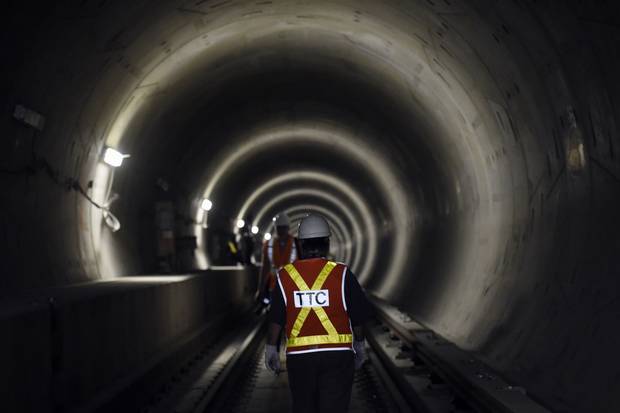
May 4, 2015: TTC workers give a site tour of Pioneer Village station. A year earlier, TTC CEO Andy Byford had ordered a review of the project that found it had only a 50-50 chance of finishing by the end of 2018. He pressed for new funding and fired senior staffers and reorganized to get it done by this year.
FRED LUM/THE GLOBE AND MAIL
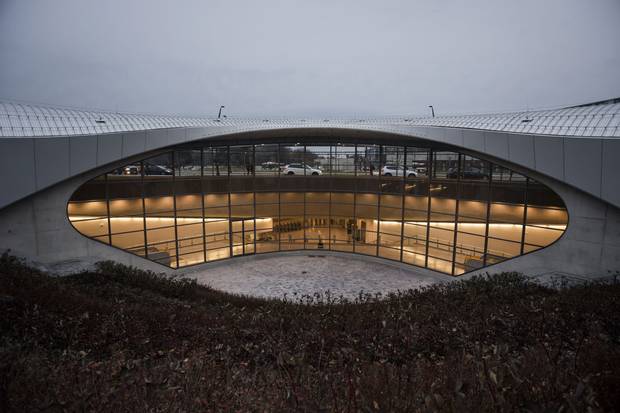
Dec. 4, 2017: The York University subway station. The TTC’s Mr. Byford says the scope and design of the stations changed a few times and were scaled back somewhat.
CHRISTOPHER KATSAROV/THE GLOBE AND MAIL
Politicians broke ground on the TYSSE in 2009. The line was supposed to open six years later, but it didn't take long for that timeline to prove not feasible. The target slipped first to 2016, and then it threatened to slide a lot further.
Mr. Byford, the TTC chief executive, points to a series of problems. The scope of the stations changed a few times, going from "utilitarian box structures to something much more grandiose" and then being scaled back to the current, still quite grand, designs. Cold winters caused delays, as did the death of a worker that shut down construction for months.
In 2014, Mr. Byford ordered a review that revealed the project had only a 50-50 chance of finishing in the final three months of 2018. By his own account, he hit the roof. He fired two senior staffers and asked politicians to spend an extra $400-million, with Toronto paying 60 per cent and York Region covering the rest. He also sought to hand over project management to construction giant Bechtel, without getting competitive bids. A new deadline was set for end of 2017.
"I certainly [put] my strong support behind the solution," Toronto Mayor John Tory said. "It got us on track to having this thing open at a proper time."
Thirty-three months later, with the project nearing completion, Mr. Byford argued he made the right decision.
"We wanted certainty," he said. "We bought certainty."
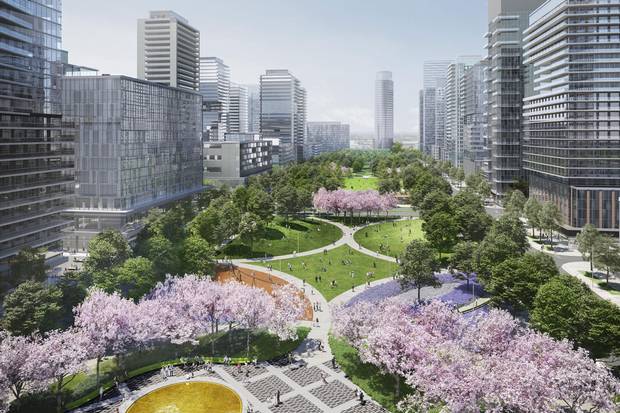
An artist’s rendering of the dense development that billionaire developer Mitchell Goldhar, the Vaughan area’s biggest landowner, has planned for the neighbourhood of the new Vaughan Metropolitan Centre subway station.
MITCHELL GOLDHAR
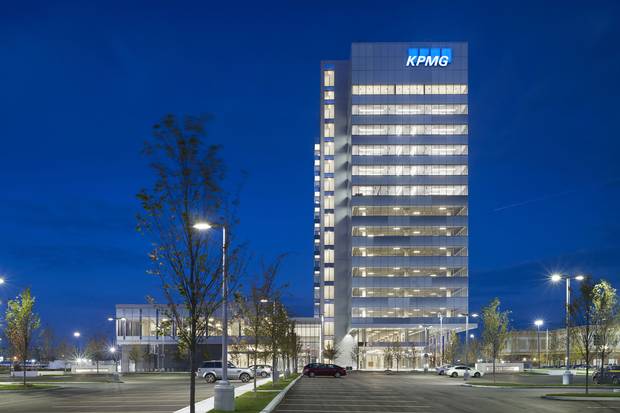
A 15-storey tower opened near the subway station last year. It is home to employees of the accounting firm KPMG and other tenants. Mr. Goldhar says he had a ‘gentleman’s agreement’ with Vaughan’s mayor to open something near the subway site before the line was ready.
MITCHELL GOLDHAR
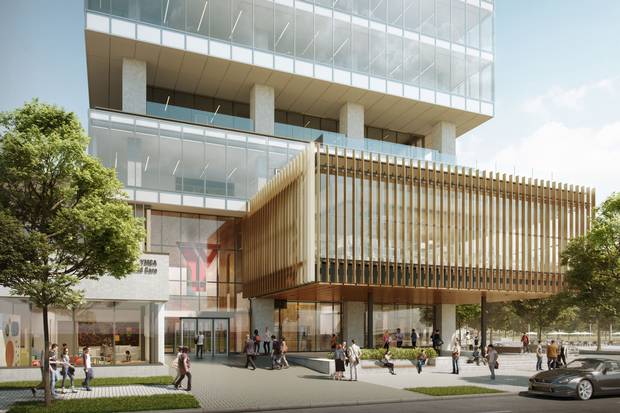
Next door to the KPMG building, work is under way on a PriceWaterhouseCoopers building, which will also feature a 100,000-square-foot YMCA recreation centre and a library.
MITCHELL GOLDHAR
Maurizio Bevilacqua, who lobbied for the line when he was a Liberal MP and has been mayor of Vaughan since 2010, dismisses the notion that Toronto has built another subway to nowhere. Instead, he argues, the new transit line has come before development, allowing subway-friendly densities to be created from next-to-nothing on top.
But years ago, Mr. Bevilacqua was worried about the optics. He told Mitchell Goldhar – the area's biggest land owner and the billionaire behind big-box developer SmartCentres who first brought Wal-Mart to Canada – that he must have something built before the line was ready.
Mr. Goldhar describes his pact with the mayor as a "gentlemen's agreement." His 15-storey tower housing employees of the accounting firm KPMG, as well as other tenants, opened last year. Work is under way on a PriceWaterhouseCoopers building next door, which will also feature a library and a YMCA recreation centre. Three planned condo towers – standing 55 storeys – are sold out.
Most of the area still remains a mix of construction sites, parking lots and pre-existing industrial low-rise and big-box retail. But much more development is planned. Mr. Bevilacqua says the new "urban feel" of the place is already palpable, and the seeds have been planted for a different way of life in the 905.
Mr. Goldhar owns half of his 100-acre plot here in partnership with Smart Real Estate Investment Trust, and the other half with his partners, suburban developers Rudy Bratty and Silvio DeGasperis. Other developers are active nearby.
Having one main developer control so much of the land around a new subway station is unusual. But it has allowed Mr. Goldhar to throw himself into custom-creating a new dense community with what he says will be a European, urban sensibility.
A parking lot to the west of the subway station, for example, will become a courtyard surrounded by retailers, restaurants and boutiques.
"It'll have character and feel. And in the middle of it will be this pedestrian space," Mr. Goldhar said. "So when you come off the subway … you'll look down the middle of this huge piazza kind of thing like you do in the centre of great cities of Europe."
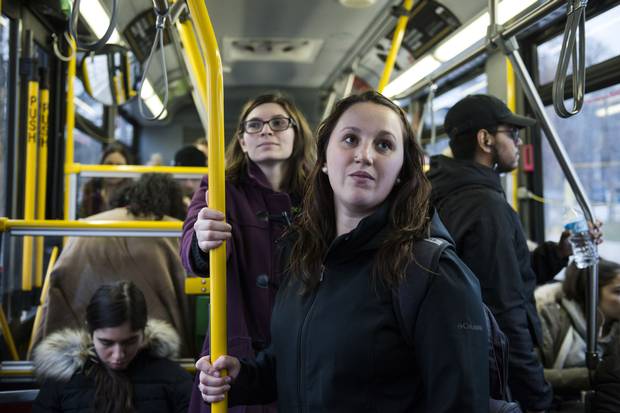
Without the extended subway line, Sarah Greenberg needs a time-consuming combination of buses and subway rides to get to campus at York University. ‘I leave two hours before I’m supposed to be there,’ she says.
CHRISTOPHER KATSAROV/THE GLOBE AND MAIL
For Sarah Greenberg, extending the subway to York University will be a game-changer. She is pursuing a master's degree in disaster and emergency management at York and commutes from the eastern Beaches, by bus and subway.
"I leave two hours before I'm supposed to be there," said the 26-year-old, who is looking forward to a faster and more comfortable trip.
Modelling by the regional agency Metrolinx suggests the line could lead to a modest reduction in Yonge subway crowding. But other effects are likely to flow from this project as well.
The TYSSE has given weight to a growing view at city hall that, in the debates over new transit lines, the number of possible riders no longer matters as much as it once did.
Toronto city councillor and TTC commissioner Glenn de Baeremaeker notes the line's ridership could have been met with light rail, or dedicated bus lanes, but the governments chose a subway.
"Whether it, quote, merits on a technical sense the ridership or not, it's a philosophical decision the city has made and society has made," he said. "People like subways."
In the same vein, boosters for other proposed transit megaprojects – including the $3.35-billion subway extension to Scarborough – regularly point to the TYSSE. If the ridership to Vaughan warrants a subway, they say, so does their area.
For Mr. Byford, though, the next subway needs to be one with an "overwhelming" business case: The proposed relief subway line, which would run from the Danforth south and then west into the core, diverting people from the Yonge line and letting pressure off the ever-more-crammed interchange at Yonge and Bloor.
"You know, people say '[build] there and they will come.' I think the most pressing need is to now focus on subway expansion where it's not so much that they will come, it's [that] there's already a demonstrable need."
BY THE NUMBERS
Vaughan Metropolitan station
![]()
Projected peak ridership by 2031*:
2,920
![]()
Transit connections:
VIVA bus rapid transit and YRT buses
![]()
TTC-controlled parking**:
none
Highway 407 station
![]()
Projected peak ridership by 2031*:
3,390
![]()
Transit connections:
18-bay GO/YRT bus terminal and link to planned Highway 407 bus rapid transit
![]()
TTC-controlled parking**:
550
Pioneer Village station
![]()
Projected peak ridership by 2031*:
2,060
![]()
Transit connections:
12-bay TTC bus terminal and five-bay terminal for YRT/Viva buses
![]()
TTC-controlled parking**:
1,881
York University station
![]()
Projected peak ridership by 2031*:
3,160
![]()
TTC-controlled parking**:
none
![]()
Projected development:
A 2009 city planning document seeks to “guide future development and redevelopment... envisioning a residential population of up to 24,500 people and up to 21,000 jobs surrounding the university”
Finch West station
![]()
Projected peak ridership by 2031*:
2,870
![]()
Transit connections:
Link to Finch LRT and a six-bay bus terminal
![]()
TTC-controlled parking**:
347
![]()
Projected development:
Unknown. A city planning study for the Finch/Keele area is currently underway
Downsview Park station
![]()
Projected peak ridership by 2031*:
1,480
![]()
Transit connections:
Sheppard buses will stop nearby
![]()
TTC-controlled parking**:
none
![]()
Projected development:
A 2011 city planning document states that “the area has the potential to accommodate up to 42,000 new residents and workers”
*One-way hourly ridership, in morning rush **Parking spaces are TTC-controlled parking only and do not include private commuter or other parking lots.
Value of 2011 station contract
In millions
Downsview ParkFinch WestYork UniversityPioneer VillageHighway 407Vaughan Metropolitan279126118166404$198279
THE GLOBE AND MAIL, SOURCE: TTC
DATA
SHARE
×
| Station | $ |
| Vaughan Metropolitan | 198 |
| Highway 407 | 404 |
| Pioneer Village | 166 |
| York University | 118 |
| Finch West | 126 |
| Downsview Park | 279 |
×
https://s3.amazonaws.com/chartprod/7jNoTxs7HoYyB5Dra/thumbnail.png
Daily station usage, select stations, by line, 2015
TYSSE*
Yonge-University
Bloor-Danforth
Sheppard
Average
Entire subway systemBessarionLeslieRunnymedePapeKiplingKennedyRosedaleQueenFinchBloor/Yonge (Yonge line)Downsview ParkHighway 407VaughanFinch WestPioneer VillageYork University26,90018,60014,50011,7006,7005,100216,190100,82048,0105,98069,79052,93028,71017,0406,6003,05038,121000038121
THE GLOBE AND MAIL, SOURCE: TTC; *FORECAST FOR WHEN USAGE MATURES, IN ABOUT THREE YEARS
DATA
SHARE
×
| Station | TYSSE* | Yonge-University | Bloor-Danforth | Sheppard | Average |
| York University | 26900 | 0 | 0 | 0 | 0 |
| Pioneer Village | 18600 | 0 | 0 | 0 | 0 |
| Finch West | 14500 | 0 | 0 | 0 | 0 |
| Vaughan | 11700 | 0 | 0 | 0 | 0 |
| Highway 407 | 6700 | 0 | 0 | 0 | 0 |
| Downsview Park | 5100 | 0 | 0 | 0 | 0 |
| Bloor/Yonge (Yonge line) | 0 | 216190 | 0 | 0 | 0 |
| Finch | 0 | 100820 | 0 | 0 | 0 |
| Queen | 0 | 48010 | 0 | 0 | 0 |
| Rosedale | 0 | 5980 | 0 | 0 | 0 |
| Kennedy | 0 | 0 | 69790 | 0 | 0 |
| Kipling | 0 | 0 | 52930 | 0 | 0 |
| Pape | 0 | 0 | 28710 | 0 | 0 |
| Runnymede | 0 | 0 | 17040 | 0 | 0 |
| Leslie | 0 | 0 | 0 | 6600 | 0 |
| Bessarion | 0 | 0 | 0 | 3050 | 0 |
| Entire subway system | 0 | 0 | 0 | 0 | 38121 |
×
TORONTO IN MOTION: MORE FROM THE GLOBE AND MAIL


